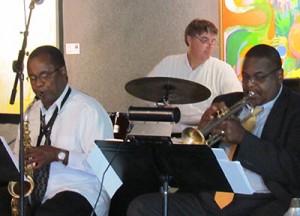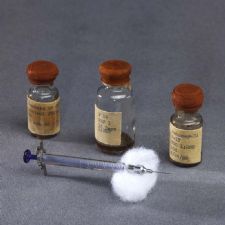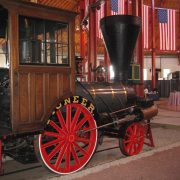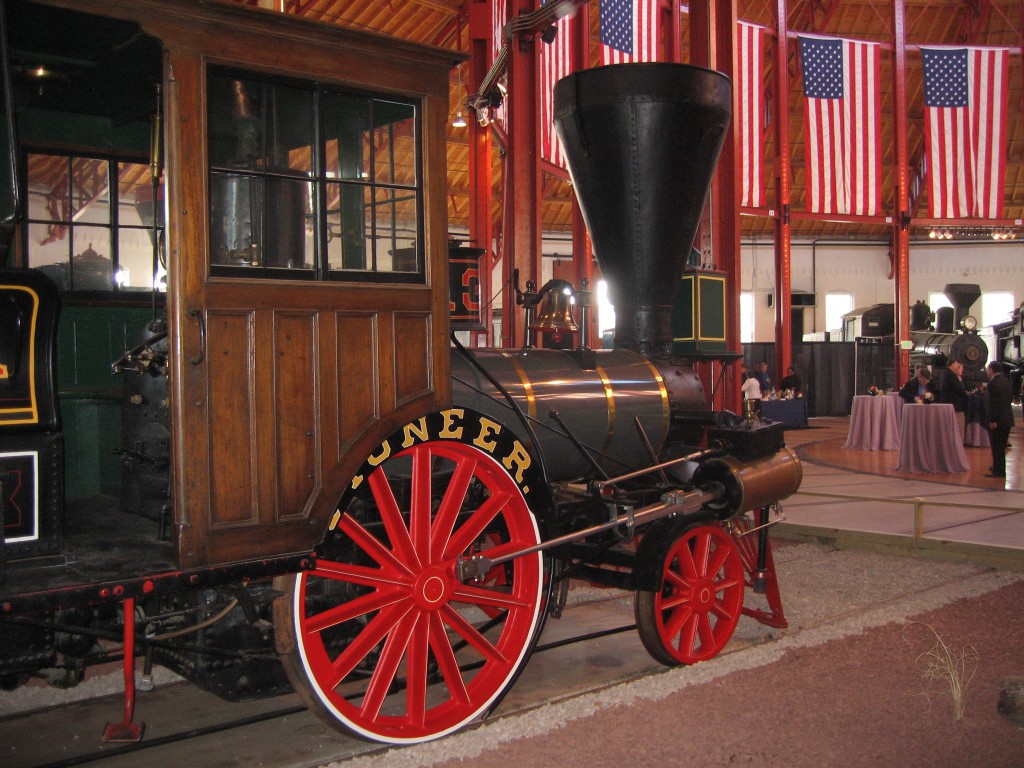3rd successful year of “September with the Smithsonian” in Daytona Beach
Special thanks for this guest post to James “Zach” Zacharias, Senior Curator of Education and Curator of History at the Museum of Arts and Sciences Daytona Beach, Florida.

Zach Zacharias and Dr. Valerie Paul with “Highwaymen” on loan from fellow Affiliate, Orange County Regional History Center. Photo courtesy MOAS.
Several years ago the Daytona Beach Museum of Arts and Sciences (MOAS) was looking for ways to increase attendance during the traditionally slow month of September. After a few brainstorming sessions, the curatorial and education departments came up with a brilliant idea to tie September MOAS with the Smithsonian Affiliations program. Access to the Smithsonian’s vast offerings is a perfect fit for MOAS’s educational goals. We wanted to try something radical and different- something that had never been done before. Thus came September with the Smithsonian. It proved to be all we had hoped for, and now is in its third year.
This year we included Smithsonian Affiliates from around the state to lend their expertise to content. This year also marks the 500th Anniversary of the discovery of Florida by Juan Ponce de Leon. Florida has been celebrating with statewide initiative called Viva 500. Naturally, our theme for this year’s event focused on Florida’s history and natural history. The ideas revolve around having a Smithsonian related event every week during the month and on different days. The first key to success was to contact our Affiliate National Outreach Manager Alma Douglas and discuss our theme. With Alma’s expertise, she was able to guide us to the resources and make contacts for our event.
Our first week started out with Dr. Valerie Paul, Director of the Smithsonian Marine Station at Fort Pierce. Her presentation, Exploring Florida’s Marine Environment, focused on the mission of the Smithsonian’s center and how it relates to Florida’s all-important ecosystems. Dr. Paul highlighted the cutting edge research that the Smithsonian is conducting for medical research and the important issues in Florida’s fragile coral reef ecosystems.
Our second week, Chuck Meide, Underwater Archaeologist from St. Augustine Lighthouse and Museum, a fellow Smithsonian Affiliate, gave a presentation on the underwater archaeological excavation of a colonial era shipwreck. It sank off the entrance of St. Augustine Inlet during the British loyalist evacuation of Charleston in 1782.

Dr. Kathleen Lyons in an interview with WROD’s Cadillac Jack at the MOAS Natural History Festival. Photo courtesy MOAS.
September with the Smithsonian heated up in the third week of the month with our annual weekend event MOAS Natural History Festival. It focused on the natural history of Florida and featured huge displays of fossils, shells, minerals and other specimens. Community partners such as the local Audubon Society, local fossil club, and many other organizations made this community event a hit with families. Dr. Kathleen Lyons from the Department of Paleobiology at the National Museum of Natural History presented two lectures focusing on the legacy of the giant ice age animals that once dominated Florida landscape from Giant Ground Sloths to Mastodons.
Our month long series culminated with free admission during Smithsonian magazine Museum Day Live! and two performances by the Smithsonian Jazz Masterworks Orchestra. It is the orchestra-in–residence at the National Museum of American History. For the third year in a row, this world-class jazz band has traveled to Daytona Beach to play for sold-out crowds. This year, the theme was Swinging with the Smithsonian featuring the Ella Fitzgerald Song Book.
The Jazz Masterworks Orchestra conducted a matinee jazz show for kids called Swingin’ with the Smithsonian Junior. Young musicians from the community flocked to the performance to hear this great educational event. The musicians demonstrated their instruments, discussed the concept of jazz music, and focused the importance of playing an instrument no matter what age or level you are at.
The featured evening event was under the executive direction of Kennith Kimery and artistic director and principal saxophonist Charlie Young. With special guest vocalist Lena Seikaly, it showcased the music of legendary songstress Ella Fitzgerald. The audience was treated to some of Ella’s best and most famous works.
The Museum of Arts and Sciences, Daytona Beach Florida has developed a long-standing relationship with the Smithsonian Affiliations program to bring resources to our community that would normally be out of reach. The ability to bring in scholars, programs, and artifacts has allowed the MOAS to enrich our members and community and inspire lifelong learning.











